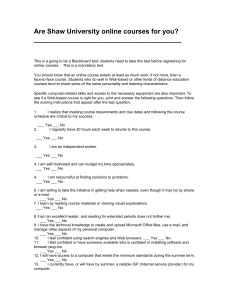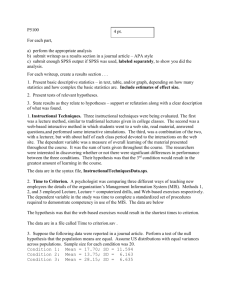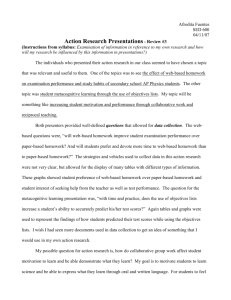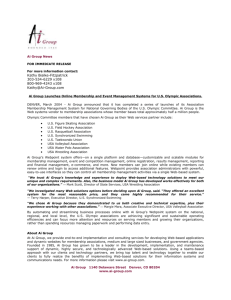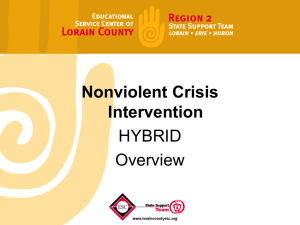Development of Web-Based Courses: A Software Engineering
advertisement
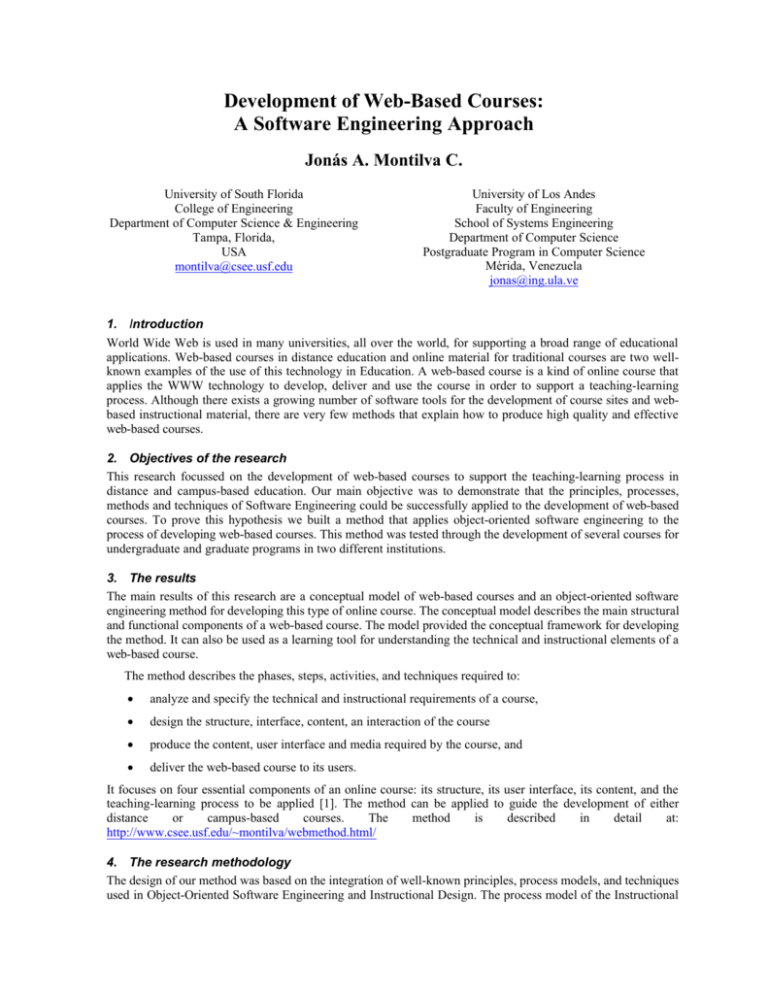
Development of Web-Based Courses: A Software Engineering Approach Jonás A. Montilva C. University of South Florida College of Engineering Department of Computer Science & Engineering Tampa, Florida, USA montilva@csee.usf.edu University of Los Andes Faculty of Engineering School of Systems Engineering Department of Computer Science Postgraduate Program in Computer Science Mérida, Venezuela jonas@ing.ula.ve 1. Introduction World Wide Web is used in many universities, all over the world, for supporting a broad range of educational applications. Web-based courses in distance education and online material for traditional courses are two wellknown examples of the use of this technology in Education. A web-based course is a kind of online course that applies the WWW technology to develop, deliver and use the course in order to support a teaching-learning process. Although there exists a growing number of software tools for the development of course sites and webbased instructional material, there are very few methods that explain how to produce high quality and effective web-based courses. 2. Objectives of the research This research focussed on the development of web-based courses to support the teaching-learning process in distance and campus-based education. Our main objective was to demonstrate that the principles, processes, methods and techniques of Software Engineering could be successfully applied to the development of web-based courses. To prove this hypothesis we built a method that applies object-oriented software engineering to the process of developing web-based courses. This method was tested through the development of several courses for undergraduate and graduate programs in two different institutions. 3. The results The main results of this research are a conceptual model of web-based courses and an object-oriented software engineering method for developing this type of online course. The conceptual model describes the main structural and functional components of a web-based course. The model provided the conceptual framework for developing the method. It can also be used as a learning tool for understanding the technical and instructional elements of a web-based course. The method describes the phases, steps, activities, and techniques required to: • analyze and specify the technical and instructional requirements of a course, • design the structure, interface, content, an interaction of the course • produce the content, user interface and media required by the course, and • deliver the web-based course to its users. It focuses on four essential components of an online course: its structure, its user interface, its content, and the teaching-learning process to be applied [1]. The method can be applied to guide the development of either distance or campus-based courses. The method is described in detail at: http://www.csee.usf.edu/~montilva/webmethod.html/ 4. The research methodology The design of our method was based on the integration of well-known principles, process models, and techniques used in Object-Oriented Software Engineering and Instructional Design. The process model of the Instructional Systems Design - ISD [2] - was used as a methodological pattern for designing the method. It was combined with an object-oriented process model for hypermedia applications [3] and object-oriented software life cycles for developing software [4]. The design and modeling of the different components of an online course is done in the method by using the Unified Modeling Language - UML [5] -, a widely used standard for modeling software applications and systems. The method has been successfully applied in the development of three web-based courses. The first one is a distance learning course in Software Engineering. This course is part of the M.Sc. program in Computer Science at the University of Los Andes in Venezuela [6]. The other applications are two web course sites for supporting campus-based education on Software Engineering in the Department of Computer Science & Engineering at the University of South Florida, Tampa (see references [7, 8]). 5. Discussion The application of our method benefits the development of web-based courses in two respects. First, it provides a well-structured and detailed guide for helping a course development team to organize, plan and control the different activities involved in the design, production and delivery of a web-based course. Secondly, because it is based on well-known instructional design and software engineering principles and techniques, the method contributes significantly to increase the quality and effectiveness of web-based courses. The last statement was demonstrated through the application of the method in three courses conducted in two different universities during the Spring 1999, Fall 1999, and Spring 2000. MS FrontPage 97 and Netscape Communicator 4.7 were used as the main development tools for implementing the distance-based course created at ULA [6]. Excluding the online material, this course was specified, designed, and implemented in approximately three weeks. Two people participated in its development: the instructor of the course and a web designer. The use of CourseInfo 4.0, an online course development tool, proves to be very effective in the implementation of the two course sites created at USF [7, 8]. The time required to specify, design, and implement these two courses was of one week in each case. All development activities were done by the course instructor. A courseinfo administrator was in charge of generating the initial structure of the course and maintaining the course roster as required by the tool. One restriction that may preclude the application of the method is that it demands from its users some familiarity with object-oriented modeling. The UML language, which is the modeling notation used in the method, is however becoming a modeling standard not only in software development but also in many other disciplines involving the modeling of systems. References [1] M.G. Moore and G. Kearsley. Distance Education: A Systems View, (Belmont, California, Wadsworth Publishing Company, 1996). [2] W. Dick and L. Carey. The Systematic Design of Instruction, (Glenview, IL, Scott, Foresman & Co., 1885). [3] J.A. Montilva. “Applying software process models to the development of hypermedia applications”. In Spanish. (Proc. of the XXII Latin-American Conference on Informatics , Vol.2, 1996, p. 870-881). [4] B. Bruegge, and A. H. Dutoit. Object-Oriented Software Engineering. (Prentice-Hall, 2000). [5] G. Booch, I. Jacobson, and J. Rumbaugh. The Unified Modeling Language User Guide. (Addison-Wesley, 1998). [6] J. Montilva. Study Guide of the Object-Oriented Software Engineering Course. In Spanish. (Universidad de Los Andes, Facultad de Ingeniería, Postgrado en Computación, Mérida, Venezuela, 1999). http://www.centauro.ing.ula.ve/isoo [7] J. Montilva. Software Engineering Course Site. (University of South Florida. Department of Computer Science & Engineering, Florida, USA. 2000). http://www.csee.usf.edu/~montilva/cen4020-002/cen4020.html [8] J. Montilva. Software Design Methods Course Site. (University of South Florida. Department of Computer Science & Engineering, Florida, USA. 2000). http://www.csee.usf.edu/~montilva/cis4930/cis4930.html
